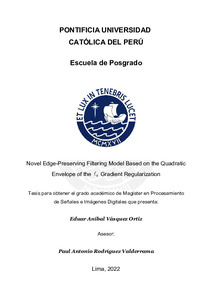| dc.contributor.advisor | Rodríguez Valderrama, Paul Antonio | |
| dc.contributor.author | Vásquez Ortiz, Eduar Aníbal | |
| dc.date.accessioned | 2023-01-26T23:51:16Z | |
| dc.date.available | 2023-01-26T23:51:16Z | |
| dc.date.created | 2022 | |
| dc.date.issued | 2023-01-26 | |
| dc.identifier.uri | http://hdl.handle.net/20.500.12404/24145 | |
| dc.description.abstract | In image processing, the l0 gradient regularization (l0-grad) is an inverse problem which penalizes the l0 norm of the reconstructed image’s gradient. Current state-of-the art algorithms for solving this problem are based on the alternating direction method of multipliers (ADMM). l0-grad however, reconstructs images poorly in cases where the noise level is large, giving images with plain regions and abrupt changes between them, that look very distorted. This happens because it prioritizes keeping the main edges but risks losing important details when the images are too noisy. Furthermore, since kÑuk0 is a non-continuous and non-convex regularizer, l0-grad can not be directly solved by methods like the accelerated proximal gradient (APG). This thesis presents a novel edge-preserving filtering model (Ql0-grad) that uses a relaxed form of the quadratic envelope of the l0 norm of the gradient. This enables us to control the level of details that can be lost during denoising and deblurring. The Ql0-grad model can be seen as a mixture of the Total Variation and l0-grad models. The results for the denoising and deblurring problems show that our model sharpens major edges while strongly attenuating textures. When it was compared to the l0-grad model, it reconstructed images with flat, texture-free regions that had smooth changes between them, even for scenarios where the input image was corrupted with a large amount of noise. Furthermore the averages of the differences between the obtained metrics with Ql0- grad and l0-grad were +0.96 dB SNR (signal to noise ratio), +0.96 dB PSNR (peak signal to noise ratio) and +0.03 SSIM (structural similarity index measure). An early version of the model was presented in the paper Fast gradient-based algorithm for a quadratic envelope relaxation of the l0 gradient regularization which was published in the international and indexed conference proceedings of the XXIII Symposium on Image, Signal
Processing and Artificial Vision. | es_ES |
| dc.language.iso | eng | es_ES |
| dc.publisher | Pontificia Universidad Católica del Perú | es_ES |
| dc.rights | info:eu-repo/semantics/openAccess | es_ES |
| dc.rights.uri | http://creativecommons.org/licenses/by-nc-sa/2.5/pe/ | * |
| dc.subject | Procesamiento de imágenes digitales | es_ES |
| dc.subject | Procesamiento de señales | es_ES |
| dc.subject | Algoritmos | es_ES |
| dc.title | Novel Edge-Preserving Filtering Model Based on the Quadratic Envelope of the l0 Gradient Regularization | es_ES |
| dc.type | info:eu-repo/semantics/masterThesis | es_ES |
| thesis.degree.name | Maestro en Procesamiento de Señales e Imágenes Digitales. | es_ES |
| thesis.degree.level | Maestría | es_ES |
| thesis.degree.grantor | Pontificia Universidad Católica del Perú. Escuela de Posgrado | es_ES |
| thesis.degree.discipline | Procesamiento de Señales e Imágenes Digitales | es_ES |
| renati.advisor.dni | 07754238 | |
| renati.advisor.orcid | https://orcid.org/0000-0002-8501-0907 | es_ES |
| renati.author.dni | 70327659 | |
| renati.discipline | 613077 | es_ES |
| renati.juror | Silva Obregon, Gustavo Manuel | es_ES |
| renati.juror | Rodriguez Valderrama, Paul Antonio | es_ES |
| renati.juror | Murray Herrera, Víctor Manuel | es_ES |
| renati.level | https://purl.org/pe-repo/renati/level#maestro | es_ES |
| renati.type | https://purl.org/pe-repo/renati/type#tesis | es_ES |
| dc.publisher.country | PE | es_ES |
| dc.subject.ocde | https://purl.org/pe-repo/ocde/ford#2.00.00 | es_ES |







